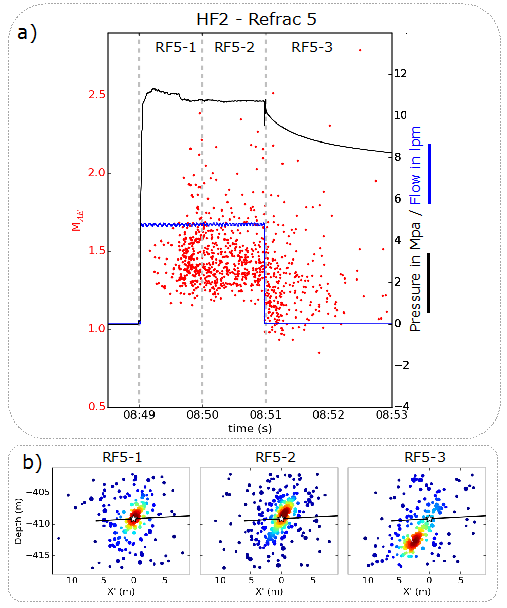Time frame
- 1 July 2017 to 30 June 2020
Funding
- BMBF (GEO:N, FONA3 Programm)
Principal Investigators
- A. Zang, GFZ Section 2.6, Germany
Personnel
- Peter Niemz, GFZ Section 2.6, Germany
Cooperations
- T. Dahm, GFZ Section 2.1, Germany;
- F. Maccaferri, GFZ Section 2.1, Germany;
- S. Cesca, GFZ Section 2.1, Germany;
- S. Hainzl, GFZ Section 2.1, Germany;
- E. Rivalta, GFZ Section 2.1, Germany;
- T. Walter, GFZ Section 2.1, Germany;
- D. Soyk, Koordinator, DGMK Hamburg, Germany;
- B. Kaus, Univ. Mainz,Germany ;
- J. Wassermann, T. Megies. LMU München, Germany;
- DEA, Germany;
- ENAGAS S. A., Spain;
- INGV, Italy;
- KNMI, The Nederlands;
- NAM, The Nederlands;
- NORSAR, Norway;
Description:
SECURE aims to develop versatile monitoring, characterization and modeling tools for the sustainable use of conventional and unconventional hydrocarbon reservoirs and geothermal systems. Probabilistic approaches for the description and the development of microcracks will be implemented in order to image and model the stability and integrity of different reservoir systems. The research is focused on hydromechanical processes, which are accompanied by crack formation and growth, combining physical multi-phase models with fracture mechanics. The microseismicity, expression of fracturing processes, is monitored and characterized implementing and further developing latest waveform based techniques. The applicability of these developments is supported by a close cooperation with industrial partners based in Germany and Europe, as well by a collection of case studies interesting different processes (involved in the WP2), such as conventional hydrocarbon exploitation (WP2a), gas storage (WP2b), hydraulic fracturing (WP2c) and geothermal production (WP2d).
WP2c: Hydraulic Fracturing
An essential issue is to understand the initiation and growth of induced fractures by fluid injection estimating the size, orientation, potential geometries of rupture, which may be inferred from the migration of microseismicity. In this regard, in situ rock fracture experiments conducted at underground research laboratories provide the ideal conditions to improve the characterization of hydraulic fractures growth. A very interesting and recent small-scale induced seismicity case is the one reported after the hydraulic fracturing in-situ experiment that took place 410 m below surface in the Äspö Hard Rock Laboratory (Sweden), Zang et al. (2017). The experiment aimed to compare hydraulic fracturing growth and induced Acoustic Emission (AE) activity under controlled conditions for different fluid injection schemes: continuous versus progressive fluid injection and dynamic pulse hydraulic fracturing. AE events, with magnitudes well below zero, produced by cm- to dm-scale tensile cracks were recorded in continuous mode by a near field network composed of 11 AE sensors. These piezoelectric sensors have their highest sensitive in the frequency range 1 to 100 kHz, but sampling rates were extended to 1 MHz, providing a high-quality data to analyse hydraulic fractures from meters to centimetres. Six hydraulic stimulations were performed using three different injection schemes into a borehole with 28 m long. The maximum volume of water injected was limited to 30l per test. The most significant seismicity was recorded during the conventional, continuous water injection experiment HF2.
Waveform stacking and coherence analysis techniques are here adapted using massive datasets with very high sampling (1 MHz) from HF2. An unsupervised automated full waveform detector is applied to the continuous dataset increasing the size of the AE catalogue by a factor of ~40, with more than 4000 AEs detected, against 102 AEs based on triggered recordings. The large and more complete AE catalogue allows a more robust analysis of the frequency-magnitude distribution, which has revealed important new results implying high b-values of 2.4. The magnitude of completeness is also estimated approximately MAE 1.1 and ranged between 0.77 and 2.79. These results suggest some modifications to McGarr's empirical relation, where the cumulative injected volume controls the maximum magnitude of fluid injection induced seismicity. AE locations are furthermore refined using a relative, master-event location approach. The accurate locations and characterization of these events have allowed illuminating the main rupture area, describing the geometry of the rupture plane and observing seismicity migrations for different hydraulic fracture stages (Figure 1a). The hydraulic fractures growth is then characterized by mapping the spatiotemporal evolution of AE hypocentres (Figure 1b). The AE activity is spatially clustered in a prolate ellipsoid and an asymmetric rupture process regarding to the fracturing borehole is clearly exhibited. AE events migrate upwards covering the depth interval between 404 and 414 m. After completing each injection and reinjection phase, the AE activity decreases and appears located in the same area of the initial fracture phase, suggesting a crack-closing effect.

Publications/Results
- López-Comino, J. A., Cesca, S., Heimann, S., Grigoli, F., Milkereit, C., Dahm, T. and Zang, A. (2017). Characterization of hydraulic fractures growth during the Äspö Hard Rock Laboratory experiment (Sweden). Rock Mechanics and Rock Engineering, 50, 2985 - 3001, doi.org/10.1007/s00603-017-1285-0
- Zang A, Stephansson O, Stenberg L, Plenkers K, Specht S, Milkereit C, Schill E, Kwiatek G, Dresen G, Zimmermann G, Dahm T, Weber M (2017) Hydraulic fracture monitoring in hard rock at 410 m depth with an advanced fluid-injection protocol and extensive sensor array. Geophysical Journal International 208 (2), 790-813, doi.org/10.1093/gji/ggw430


